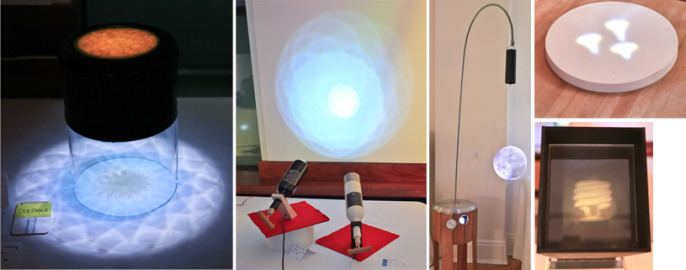Pratt is Major Catalyst for City's Economic Growth, Says Center for Urban Future Report
Report Praises Pratt's Design Incubator as Only One of its Kind in New York City
Pratt alumna Shannon South of reMade USA at work at Pratt's Design Incubator for Sustainable Innovation, which has helped launch 25 businesses since its 2002 inception.
Pratt Institute is a major driver of New York City's economic engine, according to a March 2012 report published by the Center for an Urban Future (CUF), a Manhattan-based think tank. Pratt was featured in the report for its support of entrepreneurs through The Pratt Design Incubator for Sustainable Innovation; for significant investments that demonstrate its active commitment to the local community; for the number of degrees it awards to designers and architects, many of whom work for New York City's leading design and architectural firms; and for the talent it brings to the city from around the globe.
The report, titled "Designing New York's Future," draws from a wide range of institutional data, survey results, and extensive interviews with representatives from New York's design and architecture communities. It acknowledges New York City's design colleges as critical catalysts for innovation, entrepreneurship, and economic growth that are poised to play an even more central role in New York's economic future.
"The results of the report are no surprise as Pratt Institute is one of the world's foremost design institutions and has played an active role in New York City's economy and culture for the past 125 years. I'm pleased that the report helps quantify Pratt's impact in a way that illustrates the depth of its influence," said Pratt Institute President Thomas F. Schutte. "We take great pride in the fact the majority of our graduates stay in the New York City area, many near Pratt's home in Brooklyn, to start their own businesses or to become leaders at the city's top creative firms," he added.
The report highlighted the Pratt Design Incubator for Sustainable Innovation, the only one of its kind among colleges of art and design in New York City, as a prime example of an initiative that fuels new businesses and spurs economic growth. The Pratt Design Incubator was founded in 2002 by Debera Johnson to help student thesis projects move toward viable, sustainably focused business enterprises and is based in the Brooklyn Navy Yard. Since its inception, it has helped launch over 25 businesses in clean-tech, social innovation, fashion design, design consulting, furniture design, and product design. The businesses collectively support 60 jobs and $4 million in revenue per year.
The report cites Pratt Institute investments like Myrtle Hall, the Institute's LEED-gold certified academic and administrative building located on the revitalized Myrtle Avenue commercial district in Brooklyn, as vital to community development. Myrtle Hall, which opened in 2010, was highlighted as an example of a multi-million dollar investment by a New York design college that "provided new amenities for students and benefited the urban fabric of the surrounding neighborhoods." Since becoming president of Pratt Institute in 1993, Thomas F. Schutte has worked tirelessly to revitalize the area surrounding Pratt, and serves as chair of the Myrtle Avenue Brooklyn Partnership.
One of the report's key focuses is on the entrepreneurial talents of the city's design college graduates, many of whom stay in the city upon graduation. The report cites a 2009 survey from the Strategic National Arts Alumni Project (SNAPP) that found that 19 percent of all Pratt, Parsons, and SVA graduates, including non-design graduates like performing arts majors, went on to start their own businesses; the average for all the art schools surveyed by SNAPP was 14 percent. In CUF's 2011 survey of trade association members, an equivalent 19 percent of New York City design college graduates indicated that they had either founded their own businesses or moved into an executive position at an existing one.
The report quoted Debera Johnson, founder of the Design Incubator and Pratt's academic director of sustainability, on the successes of the Design Incubator and she talked about plans to triple its size. Pratt Provost Peter Barna was quoted as equating freelancers with sole-proprietorships, encouraging freelancers who want to be successful to function like a small business.
A number of Pratt alumni were also quoted, including Sam Cochran, Steph Mantis, and Diane Ruengsorn in a special Q and A section with young design entrepreneurs. Cochran, a member of Pratt's Design Incubator, said the Design Incubator is the best resource for Pratt student designers in providing the expertise needed to start a business, and mentioned how, as a student, he would seek guidance from his Pratt professors for getting a business off the ground. Mantis talked about her experience in taking an idea she had for a product, manufacturing it, and selling it with great success. Ruengsorn stressed the need for business training to go "further and faster."
The report also notes that New York City graduates twice as many students in design and architecture as any other U.S. city at 4,278, compared to the city with the second most graduates, Los Angeles, at 1,769, according to 2010 figures. Enrollment at New York's design colleges has been growing at a faster rate than at other universities in the city, up 34 percent between 2001 and 2010.
Pratt is number six in the country for the number of design degrees awarded each year, and number eight in the country for the number of architecture degrees awarded each year.
The Center for an Urban Future is dedicated to independent, fact-based research about critical issues affecting New York's future, including economic development, workforce development, higher education, and the arts. For more information, please visit www.nycfuture.org.
To download the full report, please click here.
Text: Amy Aronoff
Photo: Jonathan Weitz

 Gateway Editors
Gateway Editors

